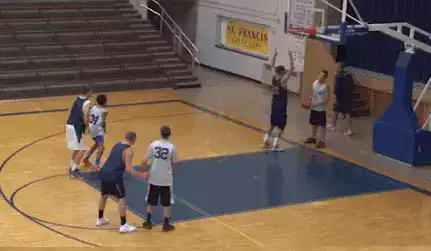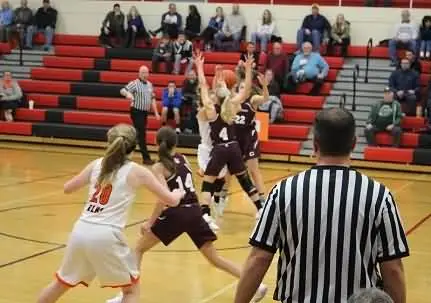Basketball Press Defense
By Dr. James Gels, From the Coach’s Clipboard Basketball Playbook"Helping coaches coach better..."
Basketball press defense extends your defense into the opponent's back-court. Before selecting and teaching a defensive press system, first decide whether an uptempo, pressing defense is best for your team. Do you have team quickness, well-conditioned athletes, and a good bench? Will your players buy into and be committed to a pressing defense?
There are man-to-man and zone presses. Our favorite (high school varsity level) is the full-court matchup press defense, initially pioneered by Rick Pitino at Kentucky.
Advantages of a Good Basketball Press Defense
A good press can create back-court turnovers, steals and easy baskets for your team. So it is an offensive weapon as such, and a way to come from behind, or a way to break open a close game, and a way to wear down a slower, not well-conditioned opponent.It may help nullify the opponent's "bigs", who may labor to get up and down the floor. You can turn the game into a track meet, rather than a slow-down game that favors the opponent's big post players.
The press keeps the opponent off-balance, changes the tempo of the game, and often has the opponent doing things they don't normally like to do. It often forces the opposing coach to use valuable time-outs. It favors a well-conditioned team with a deep bench, and with more substitutions, allows more of your players to get playing time.
Coach, looking for an organized library of helpful basketball information? Coach's Clipboard is a long-standing trusted basketball coaching resource used by coaches worldwide, at all levels - a basketball coach's encyclopedia.
Watch Video Register now
New! Become a member and create your own online playbook.
Tip: Basketball Coaching 101 - How to use this basketball playbook
Watch Video Register now
New! Become a member and create your own online playbook.
Tip: Basketball Coaching 101 - How to use this basketball playbook
Categories of Press Defenses:
Press Defenses
Disadvantages of a Press Defense
A fair amount of practice time is required to develop a good, cohesive press. Also, remember that any press is a gamble (especially trapping defenses). You risk giving up the easy transition lay-ups, and you have to be willing to accept that fact.See Transition Defense for important principles that apply to all press defenses.
Full-Court Man-to-Man Pressure Defense
Full-court "pressure" defense is simple man-to-man defense extended over the full-court. This defense is excellent for youth teams who must learn to play man-to-man defense, and it is easy to teach, requiring less practice time than other press defenses.Players use and learn the same basic concepts of man-to-man defense - on-ball, deny and help-side defense, just extended to the full-court. There is little risk, or gambling, with this defense. This press would probably be less effective at higher levels where good ball-handling guards could break it down.
Bob Kloppenburg's Full-Court SOS Pressure Defense - transition and full-court aspects of the SOS defense.
Zone Press Defense
Zone presses have the defenders start in a certain formation, such as a 1-2-1-1, 1-2-2, 2-2-1, etc. and feature pressuring the ball and trapping. You can categorize zone presses by where the press starts on the court:- full-court ("80"), with a defender guarding the inbound passer (e.g. 1-2-1-1 zone press)
- 3/4 court ("60"), with nobody guarding the inbound passer (e.g. 2-2-1 zone press)
- half-court ("40") where the press starts at, or just beyond, the half-court line (e.g. 1-2-2 Viking press)
Specific Zone Presses
Paul Murray's 21 Full Court Press
1-2-1-1 "diamond" zone press... try to tip the inbounds pass, trap the first pass in the corner, or along the sideline. Vulnerable along the sidelines at half-court, but you can adjust to a 1-2-2 (but then there is no defender back deep as a safety).
2-2-1 zone press... allow the inbounds pass (to the corner), get the ball-handler to commit, and then aggressively trap and rotate.
Coach Sar's 3/4-court 1-2-2 press... Coach Ken Sartini's pressing system.
3-1-1 3/4-court press... a zone press that you can use against teams that show a "3-Up" press-breaker. A 3-2 adjustment is included.
Paul Murray's 21 Full Court Press
1-2-1-1 "diamond" zone press... try to tip the inbounds pass, trap the first pass in the corner, or along the sideline. Vulnerable along the sidelines at half-court, but you can adjust to a 1-2-2 (but then there is no defender back deep as a safety).
2-2-1 zone press... allow the inbounds pass (to the corner), get the ball-handler to commit, and then aggressively trap and rotate.
Coach Sar's 3/4-court 1-2-2 press... Coach Ken Sartini's pressing system.
3-1-1 3/4-court press... a zone press that you can use against teams that show a "3-Up" press-breaker. A 3-2 adjustment is included.
Match-up Press Defenses
Our match-up press defense is a more complicated "system" of presses compared to simple zone presses and involves a fair amount of practice time. We begin teaching this system at the freshmen and JV levels, and fine-tune it at the varsity level. It has the advantage of always having pressure on the ball no matter what press-breaker the offense uses.
The match-up press is different from a zone press in that we have our defenders all match-up with someone when the ball is inbounded... much like man-to-man defense. So it doesn't matter what press-breaker the opponent uses. Techniques such as "cut & double", "run & jump", and "run & double" are presented.
Full-court ("80") presses of various alignments (1-Up, 2-Up, 3-Up and 4-Up), as well as a "staggered" press are discussed. Additionally, two deny presses, "81" and "61", are presented. Use these drills "Match-up Press Drills", and see "Teaching Basketball by Progression".
Full-court ("80") presses of various alignments (1-Up, 2-Up, 3-Up and 4-Up), as well as a "staggered" press are discussed. Additionally, two deny presses, "81" and "61", are presented. Use these drills "Match-up Press Drills", and see "Teaching Basketball by Progression".
Trapping with a Trailer Defender by Coach Joao Costa.
Half-Court Press Defenses
Half-court presses start at, or just beyond, the half-court line. These presses are less of a gamble, since all five defenders are back in the half-court. These defenses trap the ball as it comes across half-court, in the half-court corner on either side, while the other defenders look to intercept a poor pass made out of the trap. These presses are usually easier to teach and conditioning is less of an issue.Specific Half-Court Zone Press Defenses
1-2-2 Viking Press Defense... a very effective half-court press.
2-2-1 Half-Court Press Defense... another half-court trapping press defense.
1-2-2 Viking Press Defense... a very effective half-court press.
2-2-1 Half-Court Press Defense... another half-court trapping press defense.
Deny Press Defenses
"Deny" presses are used to deny the inbounds pass, hopefully resulting in either intercepting the inbounds pass, or getting the 5-second call. Defenders play in the passing lanes between the ball and their man.A deny press is needed in a close game, in an attempt to get the ball back after a made basket, or whenever the opponent has to inbound the ball. It can also be used from time-to-time during the course of a game as a surprise tactic. Several deny presses are presented as adjustments to a main press.
Deny Presses are Included with These Presses
Man-to-Man Pressure Defense... "41", a full-court deny press defense.
2-2-1 Zone Press... a deny press is included.
Match-up Press Defense... "81" and "61" deny presses are included.
Man-to-Man Pressure Defense... "41", a full-court deny press defense.
2-2-1 Zone Press... a deny press is included.
Match-up Press Defense... "81" and "61" deny presses are included.
In summary, the press(es) that you decide to use should be based on your level of committment to press defense, the age and skill level of your players, the amount of practice time that you have available, your teams's quickness and athleticism, and the depth of your bench.
How you use the press is also key. Do you want to use it the entire game, to fatigue your opponent and make their "bigs" less effective? Do you just want to use it as a surprise tactic, and make the offense less comfortable?
